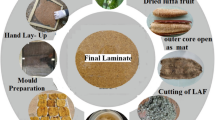Abstract
Due to the typical large variability in the measured mechanical properties of flax fibres, they are often employed only in low grade composite applications. The present study aims to investigate the reasons for the variability in tensile properties of flax fibres. It is found that an inaccuracy in the determination of the cross-sectional area of the fibres is one major reason for the variability in properties. By applying a typical circular fibre area assumption, a considerable error is introduced into the calculated mechanical properties. Experimental data, together with a simple analytical model, are presented to show that the error is increased when the aspect ratio of the fibre cross-sectional shape is increased. A variability in properties due to the flax fibres themselves is found to originate from the distribution of defects along the fibres. Two distinctive types of stress–strain behaviours (linear and nonlinear) of the fibres are found to be correlated with the amount of defects. The linear stress–strain curves tend to show a higher tensile strength, a higher Young’s modulus, and a lower strain to failure than the nonlinear curves. Finally, the fibres are found to fracture by a complex microscale failure mechanism. Large fracture zones are governed by both surface and internal defects; and these cause cracks to propagate in the transverse and longitudinal directions.













Similar content being viewed by others
References
Meijer WJM, Vertregt N, Rutgers B, Van de Waart M (1995) Ind Crops Prod 4:273
Bos HL, Van den Oever MJA, Peters OCJJ (2002) J Mater Sci 37:1683. doi:10.1023/A:1014925621252
Joffe R, Andersons J, Wallstrom L (2003) Composites A 34:603
Bledzki K, Gassan SJ (1999) Prog Polym Sci 24:221
Thomason JL, Carruthers J, Johnson KG (2011) Compos Sci Technol 71:1008
Virk AS (2010) PhD thesis, University of Plymouth, United Kingdom
Baley C (2002) Composites A 33:939
Davies GC, Bruce DM (1998) Textile Res J 68:623
Charlet K, Baley C, Morvan C (2007) Composites A 38:1912
Virk AS, Hall W, Summerscales J (2010) Compos Sci Technol 50:995
Cierpucha W, Kozlowski R, Mankowski R, Wasko J, Mankowski T (2004) Fibres Text East Eur 47:13
Harwood R, Nusenbaum V, Harwood J (2008) International Conference on Flax and Other Bast Plants Saskaaton Canada, p 118
Reme PA, Johnsen PO, Helle T (2002) J Pulp Pap Sci 28:122
Chinga-Carrasco G, Lenes M, Johnsen PO, Hult EL (2009) Micron 40:761
Terasaki Y, Noda J, Koichi G (2009) Adv Mat Res 79:235
Pickering KL, Beckermann GW, Alam SN, Foreman NJ (2007) Compos A 38:461
Andersons J, Sparnins E, Joffe R, Wallstrom L (2005) Compos Sci Technol 65:693
Mehmood S (2009) Unpublished results: Risø National Laboratory for Sustainable Energy. Technical University of Denmark, Denmark
Charlet K, Eve S, Jernot JP, Gomina M, Bread J (2009) Procedia Eng 1:233
Kölln K, Grotkopp I, Burghammer M, Roth SV, Funari SS, Dommach M, Muller M (2005) J Synchron Rad 12:739
Wang HH, Drummond JG, Reath SM, Hunt K, Watson PA (2001) Wood Sci Technol 34:493
Hill C, Hughes M (2010) J Biobased Mater Bioenergy 4:148
Thygesen LG, Eder M, Burgert I (2007) J Mater Sci 42:558. doi:10.1007/s10853-006-1113-5
Zafeiropoulos NE, Dijon GG, Baillie CA (2007) Composites A 38:621
Baley C (2004) J Mater Sci 39:331. doi:10.1023/B:JMSC.0000007768.63055.ae
Bos HL, Donald AM (1999) J Mater Sci 34:3029. doi:10.1023/A:1004650126890
Sparnins E, Andersons J (2009) J Mater Sci 44:5697. doi:10.1007/s10853-009-3785-0
Acknowledgements
The authors gratefully acknowledge Stergios Goutianos and Hans Lilholt for helpful advices and Shahid Mehmood for technical assistance, and for valuable input on fibre defects. The research has been partly funded by the European Community’s Seventh Framework Programme under grant agreement no 214467 (NATEX), and grant no 274-07-0300 (WoodFibre3D) by the Danish Agency for Science, Technology and Innovation.
Author information
Authors and Affiliations
Corresponding author
Rights and permissions
About this article
Cite this article
Aslan, M., Chinga-Carrasco, G., Sørensen, B.F. et al. Strength variability of single flax fibres. J Mater Sci 46, 6344–6354 (2011). https://doi.org/10.1007/s10853-011-5581-x
Received:
Accepted:
Published:
Issue Date:
DOI: https://doi.org/10.1007/s10853-011-5581-x




